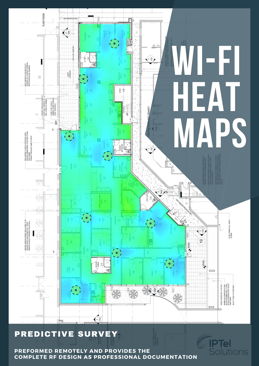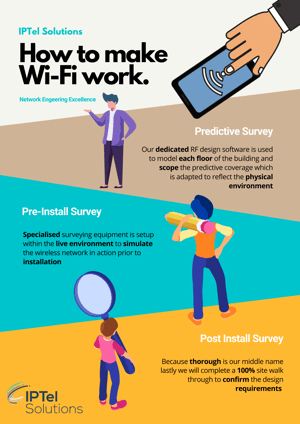In the wireless industry, price is a large factor of the vendor you choose. Rightly so, of course - if you are spending on a product, you want the best value! However, a Wi-Fi design, survey and heatmaps are not an off the shelf product.
What is a Wi-Fi Survey?
Most people have heard the various terms for Wi-Fi surveys. This could be refer to a 'desktop survey' or a 'paper based survey' (I have no idea why this term has come about - it's not a very accurate description!). These couple of terms refer to a Wi-Fi Predictive Design.
This is only the first stage in a multi stage process.
The quick summary of the types are Wi-Fi RF Survey are:
- Wi-Fi Predictive Design: The starting point for all new designs
- Wi-Fi Pre-deployment Survey: Visit site with a battery powered AP to test the walls
- Wi-Fi Deployment Validation Survey: Once installed, test the design works as expected
- Wi-Fi Diagnostic Survey: Deep dive diagnostic survey to determine root cause issues
Why Price Matters, but Quality is more Important
The title of the blog really talks to the point for your wireless installation - do you want the cheapest installation, or the best value installation? They're not the same thing.
For wireless design and installation, the cheapest job may leave you with insufficient APs and poor coverage - and quite possibly these were the issues you were trying to solve in the first place.
Wi-Fi design takes study, experience and iteration. If you learn from each installation, you will get better - but it's an expensive mistake when you don't install enough access points.
If you want devices to work properly, you have to design for those exact end user devices - and that means ensuring you've got enough APs to do the job. One of the key Wi-Fi concepts, and a saying I use is that: 'you can't bend physics'.
What I mean is that is, if you have weaker transmitting devices, then you need enough APs close enough to that device to hear it properly.
There are many use cases these days for Wi-Fi and to ensure the design works, it needs to be built for that use case. The days of "hotspot" grade Wi-Fi are long gone - the new era of Wi-Fi is all about devices and device density.
The number of devices you can support in a given area is down the density of access points - let's take a look at this question.
ASSOCIATED BLOG:
Why is AP Density Important?
So, the first point in your discussion with a potential Wi-Fi integrator is to understand what you want - and match the number and density of APs to meet that.
.gif?width=234&name=Wi-Fi%20and%20the%20Cinema%20Story%20(Instagram).gif) For example - do you want to support Wi-Fi voice? If so, 2.4GHz or 5GHz? Do you want RTLS? There's a range of services you could support - but the network needs to be designed to meet that.
For example - do you want to support Wi-Fi voice? If so, 2.4GHz or 5GHz? Do you want RTLS? There's a range of services you could support - but the network needs to be designed to meet that.
If your cheapest supplier isn't asking you these sort of questions, what are they going to design to?
Access Point Density is one of the critical measurements in proper Wi-Fi design. One of our other blogs illustrates this point quite well, while bringing the topic to life, with the Wi-Fi and the Cinema Story blog.
It is of course cheaper to install less APs at the outset - but when your devices start dropping out and you have a terrible experience for your end users, the value proposition doesn't stand up. A well function Wi-Fi network is one that's been designed to work with the end devices in mind - and "getting away" with the minimum number of APs is a risky and ultimately expensive shortcut.
ASSOCIATED BLOG:
Do you need Wi-Fi RF Design Surveys?
 Firstly, the answer is yes. If you have a small area and need a few APs, you'll get away with a guesstimate of their location. This will not hold true as you expand the size of an installation.
Firstly, the answer is yes. If you have a small area and need a few APs, you'll get away with a guesstimate of their location. This will not hold true as you expand the size of an installation.
A lot of surveys are undertaken as quickly as possible, without checks or confirmation that they meet the specification you need.
They also frequently don't include any floor maps (Wi-Fi Markup) to show you where the APs are placed - its all extra effort, but it's cheaper in the end to design properly from the start.
Proper design surveys are normally in two parts as well. You start with the desktop predictive design(we use Ekahau for this), then once complete, undertake an onsite Pre-Install survey (otherwise known as an AP-on-a-Stick survey - for reasons rather obvious in the this attached blog).
That means we have to spend some time on it, and it isn't just the specific technical aspects, but the presentation of any documentation and the follow up to work through any questions.
Do you want a partner in your installation, or just a transaction to do the cheapest job?
ASSOCIATED BLOGS:
How does Price vs Quality matter in Wi-Fi?
The difference between the cheapest and the best value can be seen in the more than just the RF design Surveys. It shows in the quality of the documentation and the overall delivery.
.png?width=236&name=Wi-Fi%20Surveys%20(Instagram).png) With the best delivery, there are quality checks along the way, through the delivery of surveys and documentation. If you have ever had the misfortune to be presented with a network diagram that looks like a birds nest, you will know what I mean, when it's just not right.
With the best delivery, there are quality checks along the way, through the delivery of surveys and documentation. If you have ever had the misfortune to be presented with a network diagram that looks like a birds nest, you will know what I mean, when it's just not right.
And messy documentation means messy onsite work. Bad patching. Bad cable management. All this means when it comes time to upgrade your network, it will not be capable of handling the upgrade, making you spend even more than you already have to.
So, yes, quality costs more - we all understand that. With networks and Wi-Fi design in particular, you need to be willing to pay more to get a better result.
This is the first point - compare the quality of documentation from your prospective suppliers and that will give you a pretty good indication of what's to come.
ASSOCIATED BLOGS:
Wireless Access Points
Let's say you get a couple of quotes for comparison quote and one has fewer APs than the other. Maybe it is sold as a 'data only' service, in which case all well and good: you don't care about smaller weaker transmitting devices roaming.
When the time comes though, it is going to cost more to upgrade that network. You will have to move Access Points around to accommodate the additional Access Points that would be introduced - more costly than designing everything in the right spot in the first place.
Wireless security is pretty important of course, and your choice of AP should reflect the corporate needs of your business.
ASSOCIATED BLOGS:
Wireless: Advanced Services
Assuming that you do want to support RTLS, voice and other advanced services, then you do need more APs.
With fewer APs, they will run at a higher power, not give you enough cell overlap and devices won't roam properly. You will really notice the difference between a good and bad Wi-Fi installation once you deploy voice services, or other real time services (think of patient monitoring in a hospital as an example).
And here's the kicker - your cheaper survey will most likely look quite good on a predictive survey, but you are left scratching your head as to why you keep getting drop outs on your phones when its actually commissioned.
Why does this happen? If you would like a more in depth view on this, you can check out our previous blog articles on Access Point Power caps.
ASSOCIATED BLOGS:
Wireless: Cheapest or Best Value: Summary
 When we quote on the services to undertake a design, we need to ask you some questions.
When we quote on the services to undertake a design, we need to ask you some questions.
If we know you want to run real time services on low powered devices, we take into account the power that they would run at to support phones and lower powered devices.
This may make it more expensive from the outset, but it comes with more benefits, like allowing the network to support more client and have a higher bandwidth between all of your clients. The lack of support calls alone will save money.
The value is better if the network does what you actually need!
If you want to read a bit more about how to get your Wi-Fi working, the Top 8 Secrets to Great Wi-Fi is a free download.
In conclusion: Wireless networks are not something that you want to go cheapest with. If you are building a network, you need the best value, not the cheapest to deliver the network you actually need.
ASSOCIATED BLOGS:






.gif)
.gif)